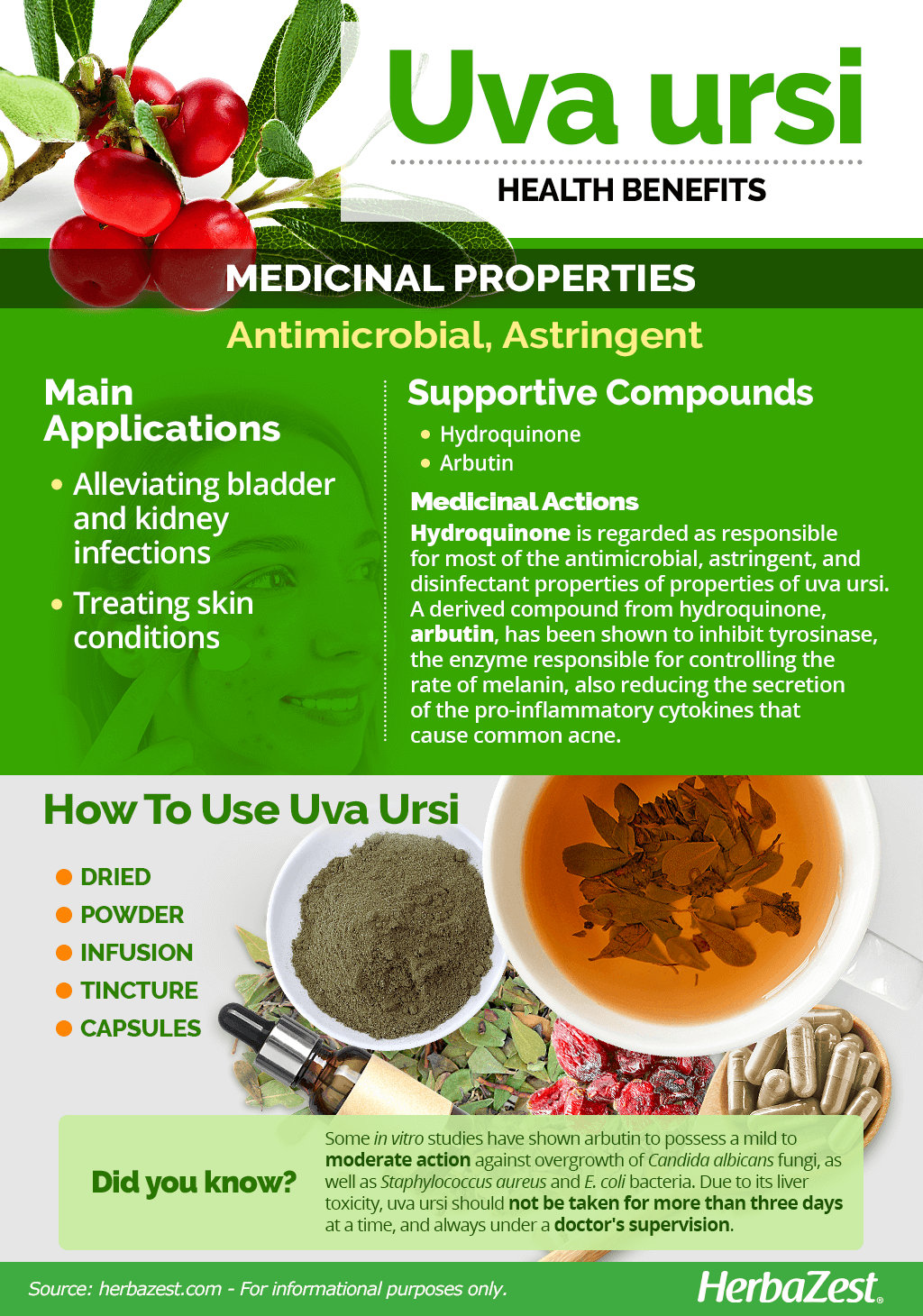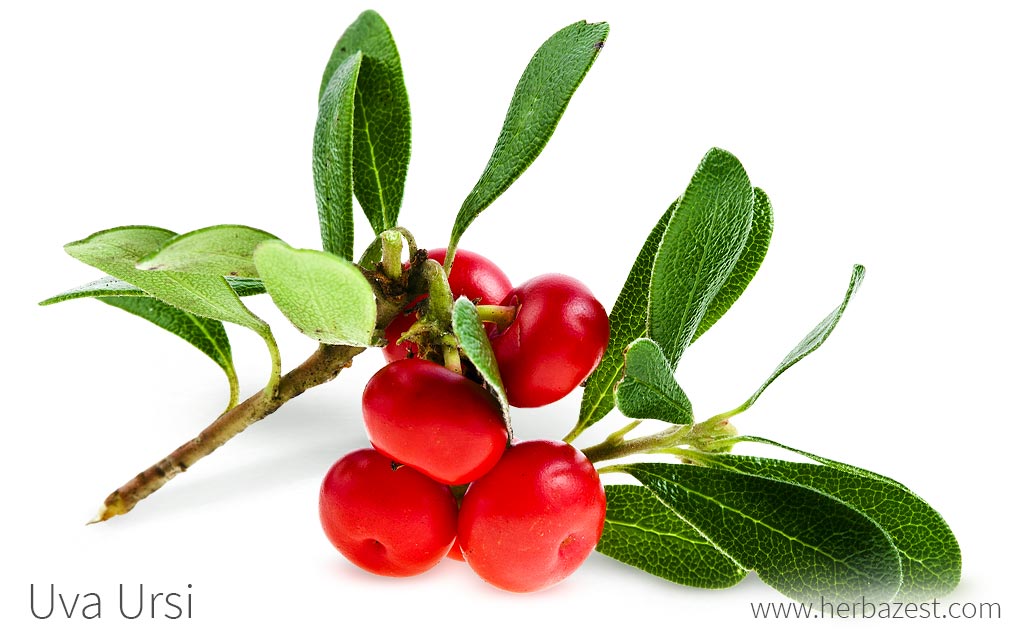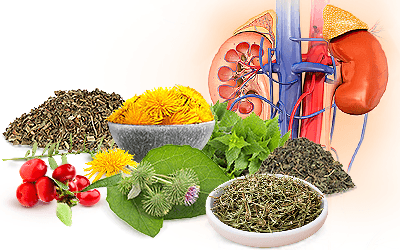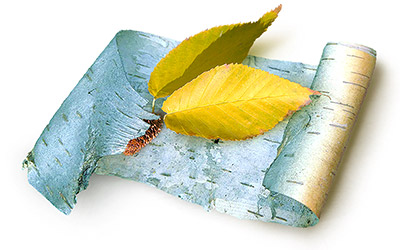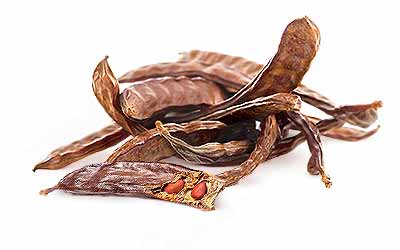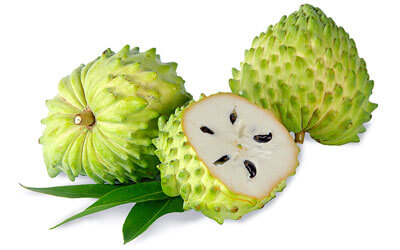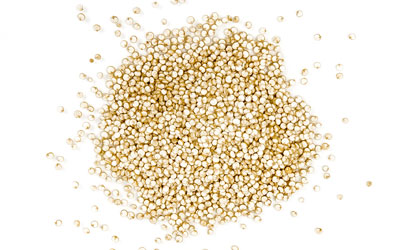The name of this herb means "bear-grape" in Latin, referring to the fact it is loved by bears, which is also reflected in the alternative name "bearberry." Uva ursi is native to Europe and is widely distributed in the arctic. It is commonly found in Europe, Asia, and North America. The plant grows best in damp conditions and is generally found in undergrowth, heathland, and grassland.
Uva Ursi Medicinal Properties
Health Benefits of Uva Ursi
To date, little scientific research has been carried out on uva ursi, and much more studies are needed to validate its alleged benefits. However, its popularity is rooted in traditional uses. So far, investigations suggest as possibly effective the following uva ursi benefits:
Alleviating bladder and kidney infections. Uva ursi has been traditionally used almost exclusively for supporting urinary health.
Treating skin conditions. The topical application of uva ursi extracts can soothe dermatological problems, such as common acne and sunspots.
How It Works
Hydroquinone is the main active compound found in uva ursi, and it is regarded as responsible for most of the herb's antimicrobial, astringent, and disinfectant properties.1,2 A derived compound from hydroquinone is arbutin, which have been reported to reduce tyrosinase activity (the enzyme responsible for controlling the rate of melanin), also inhibiting the secretion of pro-inflammatory cytokines in Cutibacterium acnes (C. acnes) infections, the main cause of acne vulgaris.3
UVA URSI OFFERS ANTIMICROBIAL AND DISINFECTANT PROPERTIES.
Some in vitro studies have shown arbutin to possess a mild to moderate action against overgrowth of Candida albicans fungi, as well as Staphylococcus aureus and E. coli bacteria.
Herbs with diuretic properties, commonly used for preventing and treating urinary tract infections, are blueberry, buchu, cranberry, echinacea, and horsetail.
Uva Ursi Side Effects
General side effects reported include mild nausea, vomiting, irritability, and insomnia.
Uva Ursi Cautions
The liver-damaging effects of uva ursi can be attributed to hydroquinone (HQ). Uva ursi has also been linked with albuminuria, hematuria, and urinary casts.
Pregnant or breastfeeding women, as well as those with high blood pressure, Crohn's disease, kidney or liver disease should avoid taking uva ursi completely.
Due to its liver toxicity, uva ursi should not be taken for more than three days at a time, and always under a doctor's supervision.
- Medicinal action Antimicrobial, Astringent
- Key constituents Hydroquinone, arbutin
- Ways to use Capsules, Hot infusions/tisanes
- Medicinal rating (1) Very minor uses
- Safety ranking Safety undetermined
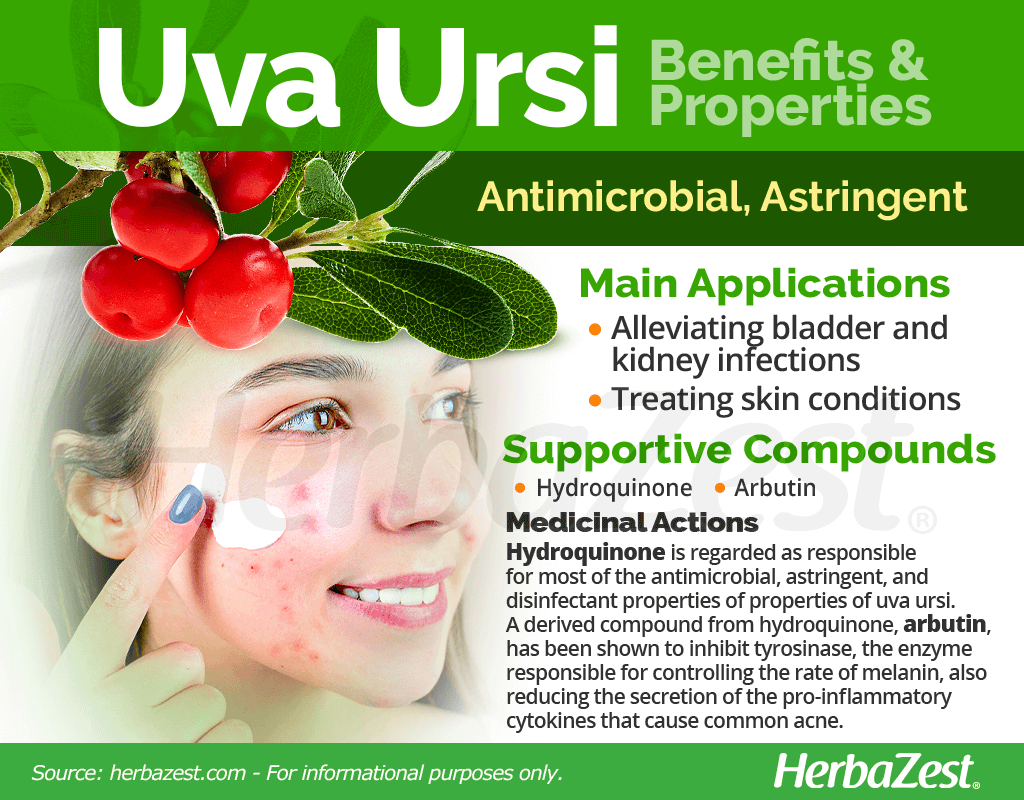
How to Consume Uva Ursi
Natural Forms
Dried. The dried leaves of uva ursi can be used to prepare herbal remedies.
Powder. The dried and pyulverized leaves of uva ursi can be used in a variety of herbal preparations.
Infusion. Uva ursi dried leaves can be steeped in hot water and taken orally to promote bladder health; however, the effectiveness of this preparation is yet to be corroborated by scientific studies.
Herbal Remedies & Supplements
Tincture. This concentrated form extracts the medicinal properties of uva ursi into an alcoholic solution. It needs to be diluted in water or juice.
Capsules. The dried and powdered leaves of uva ursi are marketed in supplemental form to support urinary health. A standard dose of three daily capsules is recommended. However, it is advised to read the labels, since there are many brands and different concentrations of the herb.
There is little to be gained from eating the fresh uva ursi fruit, and the excessive intake of supplement forms can be dangerous. Consult with a qualified physician before start taking uva ursi in medicinal amounts.
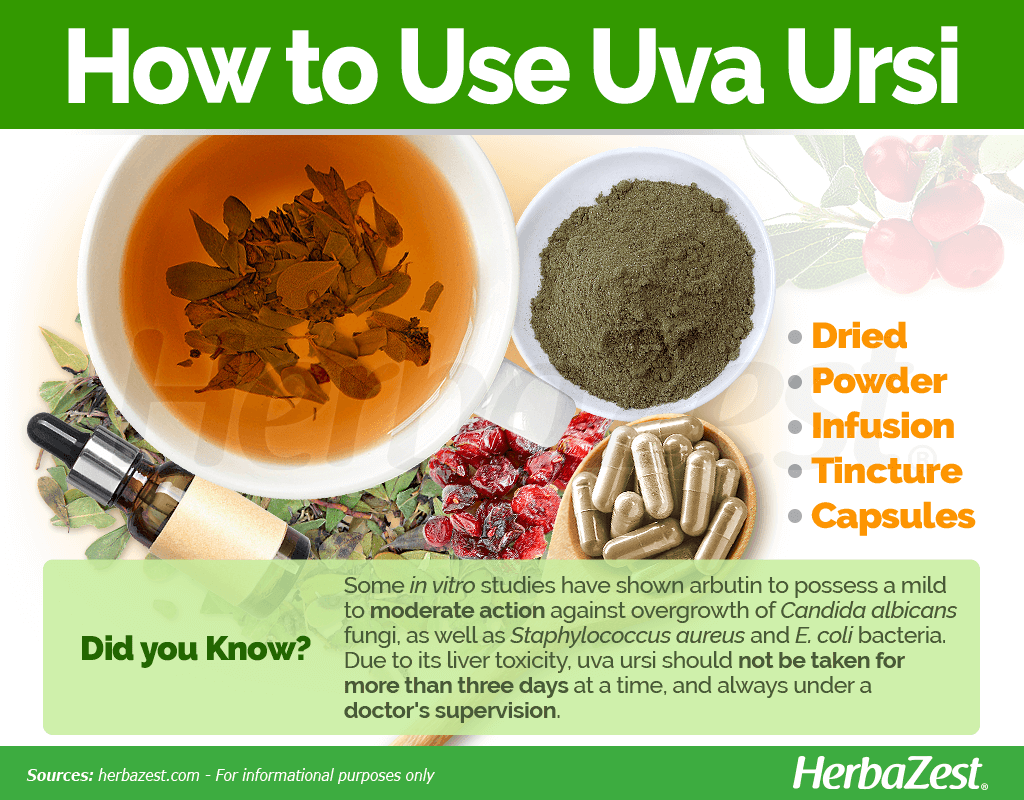
Growing
It is difficult to cultivate uva ursi as a garden plant, as it does not grow well after being transplanted from the wild, although propagation by cuttings seems to be more successful.
Growing Guidelines
The uva ursi plant grows in damp conditions, preferably under a neutral to slightly acidic soil. The best soils for uva ursi are well-drained, sandy, or gritty, and it likes exposed open sites.
Once established, this plant is extremely drought tolerant and should be placed in full sun, although it can also tolerate light shade.
The uva ursi plant is usually regarded as tolerant to most plagues and diseases, and it is rarely attacked by deer or birds, although it is susceptible to root rot and mildew, especially in southern areas.
- Life cycle Perennial
- Harvested parts Leaves
- Light requirements Full sun
- Soil Light (sandy)
- Soil pH 6.1 – 6.5 (Slightly acidic), 6.6 – 7.3 (Neutral)
- Growing habitat Arid or desert regions, Cool temperate regions, Temperate climates
- Potential diseases Mildew, Root rot
Additional Information
Plant Biology
Uva ursi is a small, wiry, evergreen shrub with bright, green leaves. The branches grow flat along the ground and are a reddish-brown color. The uva ursi flower is pink and bell-shaped, and its appearance is followed by bright red berries. One plant can cover 6 - 12 inches (15 - 30 cm) of ground.
Classification
Uva ursi (Arctostaphylos uva-ursi), also known as bearberry, belongs to the large Ericaceae family, which encompasses about 3500 species across 125 genera of small, trees, shrubs, and woody vines widely distributed around the world.
Related Species and Cultivars of Uva Ursi
The genus Arctostaphylos comprises 50 species, many of them are commonly confused with uva ursi. These include alpine bearberry (A. alpina), Santa Cruz manzanita (A. andersonii), and Mt. Diablo manzanita (A. auriculata).
Several cultivars of uva ursi have been developed, mainly for ornamental purposes, such as 'Massachusetts'.
Arctostaphylos uva-ursi is sometimes referred to as Arbutus uva-ursi, its old scientific name.
Historical Information
The history of uva ursi is mainly medicinal; the herb has little nutritional and absolutely no culinary value. Various historical peoples have used uva ursi since the 2nd century, most notably for bladder and urinary infections. Documents have been found from Wales dating back to the 13th century mentioning the use of uva ursi as a medicinal agent. For the Native Americans, it was also a popular herb to smoke with tobacco.
Sources
- Missouri Botanical Garden, Arctostaphylos uva-ursi 'Massachusetts'.
- National Toxicology Program, Chemical Information Review Document for Arbutin [CAS No. 497-76-7] and Extracts from Arctostaphylos uva-ursi
- Oregon State University, Arctostaphylos uva-ursi
- USDA Plants Database, Arctostaphylos uva-ursi (L.) Spreng.kinnikinnick ; Species, Arctostaphylos uva-ursi
- Encyclopedia of Herbal Medicine, p. 170
- Medicinal Plants of the World, p. 50
- Medicinal Herbs: A Beginner's Guide, p. 168
- Rosemary Gladstar's Herbal Recipes for Vibrant Health, p. 256, 368
- New York University - Langone Medical Center, Bladder Infection
- University of Maryland Medical Center, Uva ursi
Footnotes:
- Heliyon. (2021). Effect of naturally isolated hydroquinone in disturbing the cell membrane integrity of Pseudomonas aeruginosa MTCC 741 and Staphylococcus aureus MTCC 740. Retrieved June 1, 2023, from: https://www.ncbi.nlm.nih.gov/pmc/articles/PMC8134992/
- Applied Biochemistry and Biotechnology. (2019). Antimicrobial Mechanism of Hydroquinone. Retrieved June 1, 2023, from: https://link.springer.com/article/10.1007/s12010-019-03067-1
- Pharmaceutics. (2022). In Vitro Antibacterial and Anti-Inflammatory Activity of Arctostaphylos uva-ursi Leaf Extract against Cutibacterium acnes. Retrieved June 1, 2023, from: https://www.ncbi.nlm.nih.gov/pmc/articles/PMC9501556/
